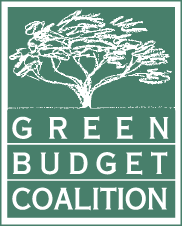The achievement of Canada’s conservation targets to protect 30% of land and ocean by 2030 (Target 3 of KMGBF) requires a new approach for funding and supporting Indigenous communities’ articulation, implementation, and stewardship of land and water use visions and plans over time. Article 26 of the United Nations Declaration on the Rights of Indigenous Peoples (UNDRIP) requires states to give legal recognition and protection to Indigenous peoples’ “right to own, use, develop and control the lands, territories and resources that they possess by reason of traditional ownership or other traditional occupation or use, as well as those which they have otherwise acquired.”
The Green Budget Coalition commends the Government of Canada’s support for Indigenous self- determined conservation and stewardship priorities, including investments in up to four Indigenous-led Project Finance for Permanence (PFP) initiatives and the launch of a First Nations Guardians Network announced at COP15. However, current funding programs do not match the demand and the extent of resourcing needed. Most of the funding presently committed to IPCAs is focused on establishing new protected and conserved areas, with little funding set aside for spatial planning or long-term stewardship. The Indigenous Guardians program is still in “pilot” phase, with demand for Guardians programs far outstripping opportunities. More fundamentally, it is increasingly clear that the current federal ‘program funding’ model does not adequately advance the Nation-to-Nation relationships required to further reconciliation and implement Indigenous rights.
Long-term stewardship depends on sustainable funding that Indigenous communities can direct towards capacity- and leadership- building priorities. As highlighted in recommendation 4.12 in the Indigenous Circle of Experts’ landmark We Rise Together report, “a more streamlined, predictable and flexible funding model is required.” Permanent financing arrangements – including endowment funds and Project Finance for Permanence – co- designed with Indigenous peoples and managed and implemented by Indigenous-led institutions, can provide the confidence and predictability that project proponents need to embark on new and ambitious conservation initiatives that uphold their socio- economic and cultural values.
Long-term funding for Crown governments, NGOs and other partners is also necessary to ensure they have the capacity necessary to meaningfully support Indigenous-led and co-led conservation initiatives.
The following key considerations should guide long- term funding allocations in support of Indigenous-led and co-led efforts to meet KMGBF Targets 1 and 3:
- Set up IPCA establishment funds (terrestrial and marine), similar to the Target 1 Challenge Fund. [ECCC, PC]
- Establish and contribute to a Project Finance for Permanence fund that supports long-term IPCA implementation. [ECCC, PC]
- Increase long-term funding for Indigenous Guardians programs and distinctions-based networks.
- Support lndigenous-led or co-led land use/ land relationship planning initiatives.
- Include long-term funding to encourage and enable provincial and territorial governments, NGOs and others to meaningfully support Indigenous-led and co-led conservation initiatives.
Recommended Investment:
Financing needs should be determined by national and regional Indigenous Governments and Organizations, and allocated to reflect the diverse distinctions and needs of their communities. In the interim, the Green Budget Coalition supports a minimum investment of $1 billion per year in permanent funding, increasing to $1.5 billion per year by 2030. [ECCC, PC]
